In our opinion, the Northern Cape in South Africa is one of the most beautiful corners of South Africa. The country’s most sparsely populated region awaits you with a unique desert landscape, the impressive Augrabies Falls, the Kgalagadi Transfrontier Park, and plenty of animal friends, such as lions, giraffes, oryx, wildebeest, and more.
Today we’d like to introduce you to a completely different side of South Africa and tell you about our Northern Cape route and its amazing highlights. Have fun browsing and hopefully copy it!
What else you should know
- Best time to travel to South Africa
- Currency in South Africa
- Entry & Visa
- Krüger National Park South Africa
- What else you should know
- The Northern Cape in South Africa
- Getting to the Northern Cape
- Rental car for the tour
- Duration of our tour
- Our Northern Cape route
- Sights and highlights
- 1. Namaqua National Park
- 2. Goegap Nature Reserve
- 3. Augrabies Falls National Park
- 4. !Xaus Lodge
- 5. Kgalagadi Transfrontier National Park
- 6. Further highlights and tips
- Our accommodations
- Cost overview & budget
- Best time to travel to the Northern Cape
- Best conditions: June to August
- Things you should bring with you
- Our conclusion about the Northern Cape
- Our FAQ – short & Crisp
The Northern Cape in South Africa
Most vacationers probably first visit Cape Town, the Garden Route, the Winelands, the Kruger National Park, and the Panorama Route. Just like us. We certainly wouldn’t have thought of spending our first trip to South Africa in the Northern Cape. The other destinations are simply far too prominent in the media, travel guides, and travel blogs.
Of the nine provinces, the Northern Cape is the largest, yet very sparsely populated. While the Western Cape has 45 inhabitants per km², the Northern Cape has just three. We quickly noticed this, too, as we often encountered only one car per hour (or a few goats) up north. The largest cities in the province are Kimberley (96,000 inhabitants) and Upington (57,000 inhabitants).
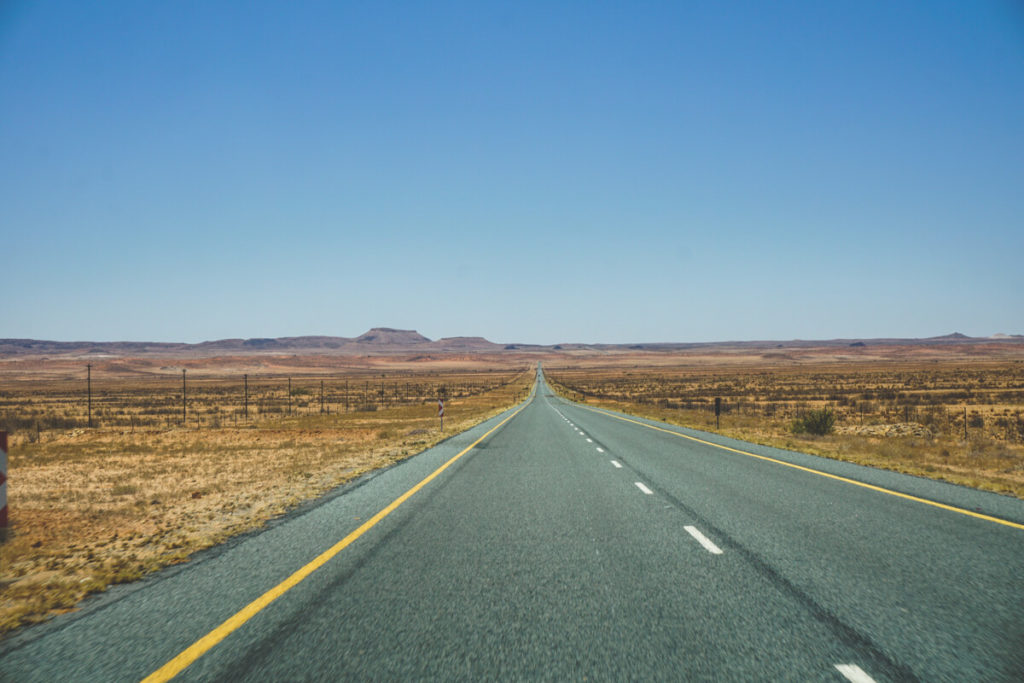
The Northern Cape borders Botswana and Namibia to the north, and the Atlantic Ocean to the west. This province is characterized by its dry, desert-like landscapes, as well as the Kalahari Desert with its fine, reddish sand. According to some climate tables, it is very hot in the Northern Cape during the South African summer, although temperatures are almost consistently above 25°C year-round.
In November, we had temperatures around 40°C at times, which was quite exhausting at times. It didn’t rain a single day. More on that below under the topic “Best time to travel to the Northern Cape.”
Getting to the Northern Cape
Before we go into detail, we’d like to tell you about our journey. We flew from Frankfurt with South African Airways to Johannesburg and then with Mango to Cape Town. We started our tour in Cape Town. We only did this one-way tour, which means we didn’t drive back to Cape Town, but flew from Upington via Johannesburg to Frankfurt.
It makes sense to start either in Cape Town or Upington. Of course, you can start in Cape Town and end your tour there, too. But with all the stops and highlights, you’ll easily have 6,000–7,000 kilometers to cover. We ended up with more than 3,000 km on the clock. Flights from Cape Town and Johannesburg to Upington and back are offered by Airlink. These domestic flights start at around €160 one-way. Alternatively, you can, of course, fly to Kimberley.
Rental car for the round trip
The roads from Cape Town to the Northern Cape are truly very well-developed. We were very surprised by this fact, but were naturally pleased that we could drive so smoothly in the north. We spent most of our time on the N7 and N14.
Even most of the branching roads were in very good condition. Nevertheless, we were recommended a four-wheel drive vehicle, as most national parks and nature reserves are almost exclusively gravel and sand roads.

And we were sooooo glad we had a large Isuzu SUV, because some of the routes would have been very stressful with a regular rental car. We had no problems with the vehicle the entire time, had enough space for our luggage (large loading area), and were able to roar over uneven roads without any worries.
The price included: an additional driver, unlimited mileage, a fair fuel policy, fully comprehensive and theft protection with no deductible, liability insurance up to €7,500,000, glass protection, tire protection, and underbody protection.
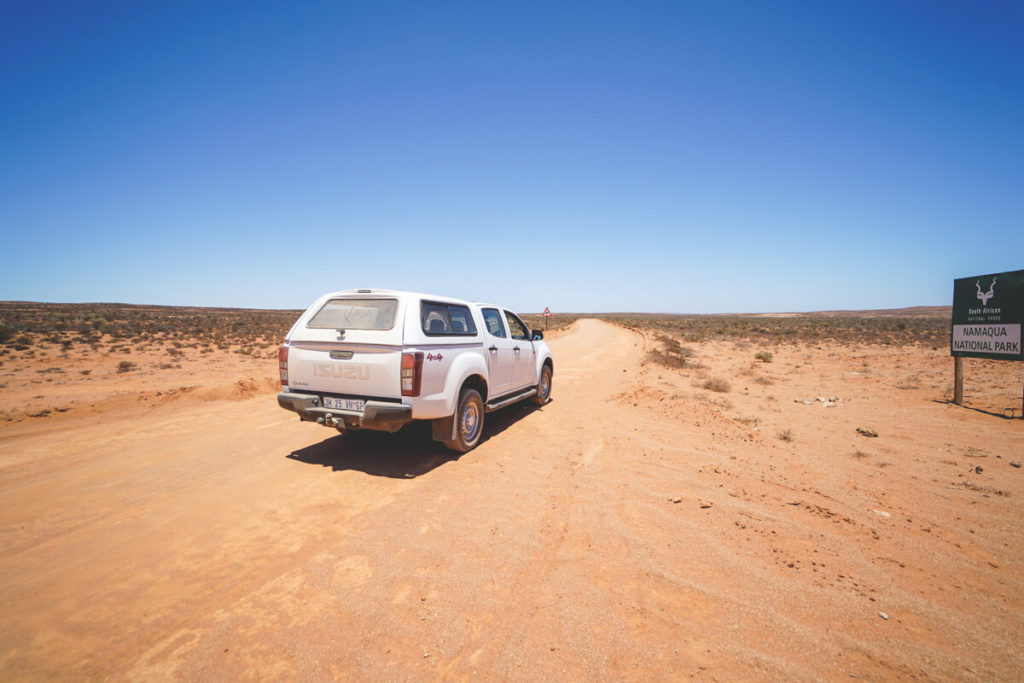
We got a new car in Cape Town that had just 1,800 km on the clock (an Isuzu with a very large cargo area). We paid around €870 for the entire period. Added to this was a one-way fee of €79, which varies depending on the route and station.
Fuel filling (diesel) cost around €205 (for almost 3,000 km). We booked the car (as almost always) through billiger-mietwagen.de*. As always, you should take plenty of photos and videos of the car before leaving the rental station.
Duration of our tour
We spent a total of 15 days in South Africa. We started off relaxed in Cape Town (2 nights), then visited the beautiful Winelands (2 nights), and then set off on an 11-day (10-night) journey through the Northern Cape of South Africa. The days in the Northern Cape were sufficient for our activities and highlights.
Generally, you can of course do much more in the Northern Cape, but you’ll need more time for that. Two weeks are certainly perfect for a good initial overview. If you have even three weeks, you can travel more relaxed and visit the places for longer.
Our Northern Cape Route
We started in one of our absolute favorite cities, Cape Town. Here, we let ourselves go again, took a really cool Cape Town helicopter tour, visited the Botanical Gardens, the colorful Bo-Kaap district, and much more. We also made a detour to the Winelands and even visited the beautiful West Coast National Park.
Our actual Northern Cape tour started in Namaqualand and ended in the town of Upington. In the end, we had covered almost 3,000 kilometers, which is quite impressive. When we drove from Johannesburg to Cape Town a few years ago, it was more than 3,200 kilometers. But we were on the road for almost 4 weeks.
- Start: Cape Town (via West Coast National Park)
- Namaqua National Park
- Goegap Nature Reserve
- Augrabies Falls National Park
- !Xaus Lodge
- Kgalagadi Transfrontier National Park
- End: Upington
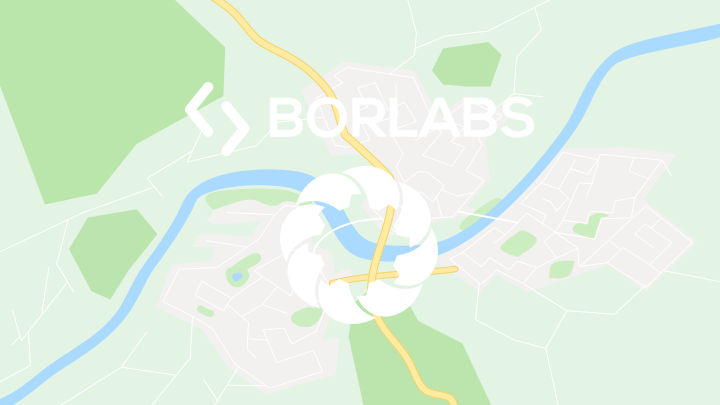
By loading the map, you accept Google’s privacy policy.
Find out more
Load map
Sights and highlights
There is a lot to discover in the Northern Cape in South Africa and you could certainly spend many weeks here and still not have seen everything. Even though the province might not seem diverse, we believe it is one of the most exciting regions in the country.
There are several national parks and nature reserves, waterfalls, hot springs, one of the largest telescopes in the world (SALT), rock paintings, mountains, museums, and much more. Above all, we wanted to be in nature, learn more about it, observe animals, and look for very special stars. Because let me tell you one thing: The starry sky in South Africa is simply gigantic!
1. Namaqua National Park
So our journey through the Northern Cape finally began. From our accommodation (Naries Namakwa Retreat*), we drove to Namaqua National Park. Unfortunately, we drove to the wrong entrance, which is why we wandered through the wilderness for two hours trying to find any kind of entrance.
After we discovered the official SANParks sign and a rickety fence, we were reassured and drove through into the park. We felt like we were in a Hollywood movie. A reddish and dusty lunar landscape surrounded us, not a soul in sight, and a silence we had never experienced before.
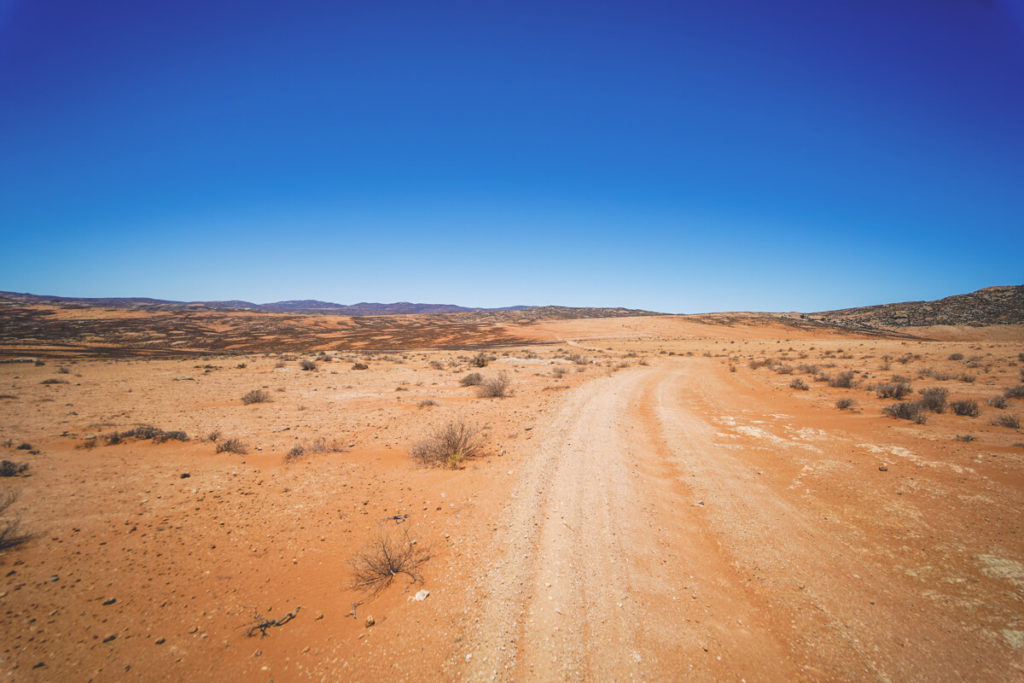
The park itself awaited us with a mountain landscape up to 1,700 meters high, a diverse flora, and many park inhabitants, such as baboons, jackals, porcupines, meerkats, zebras, antelopes, cliff divers, and even leopards. We drove through the park for several hours, enjoying the scenery to the fullest and delighting in every little animal.
Here we also spotted our very first oryx antelopes, which are definitely among the most beautiful antelope species. And even after seeing the 100th oryx at the end of the trip, we kept stopping to marvel at them. These antelopes live primarily in the dry regions and northwest of South Africa.
- Address: Namaqua National Park, XHMH+8J Soebatsfontein, South Africa
- Entrance fees: Adults R110, Children R55
- Opening hours: Skilpad Camp 7:30 a.m. – 4 p.m. | Groenriver Coastal Section 8 a.m. – 5 p.m.
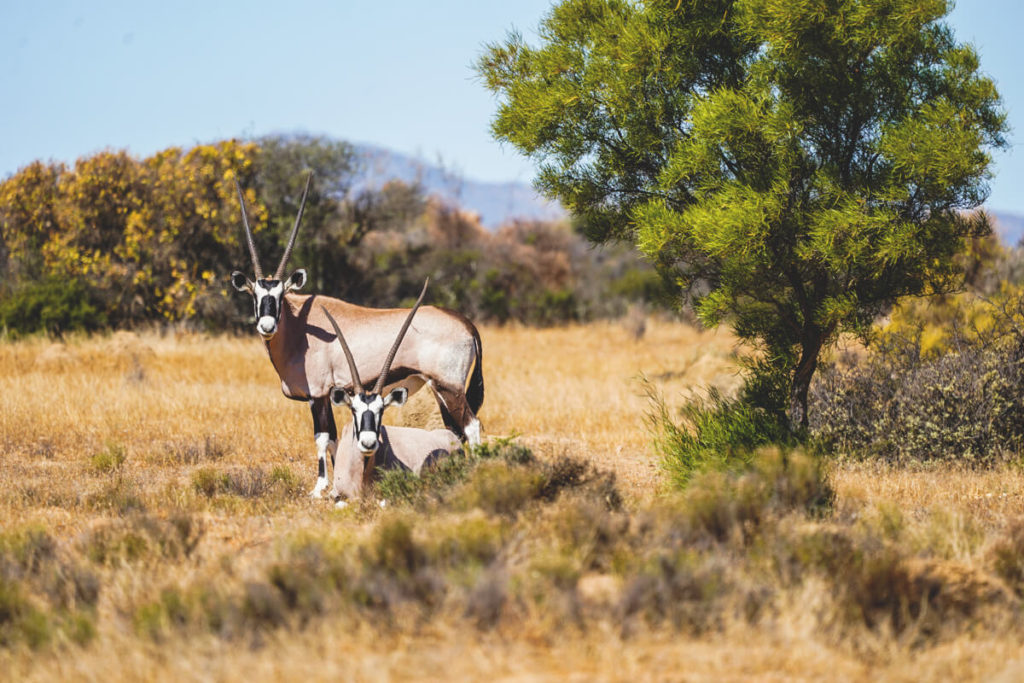
Most visitors come during the flower bloom season between July and September. Then the park transforms into a beautiful sea of flowers. There’s even a flower hotline where you can inquire about the status and the best spots (+27 – (0)21 – 4183705). To get there, be sure to drive via Kamieskroon. From there, it’s only 25 kilometers to the park’s main entrance. Here’s our detailed article: Namaqua National Park.
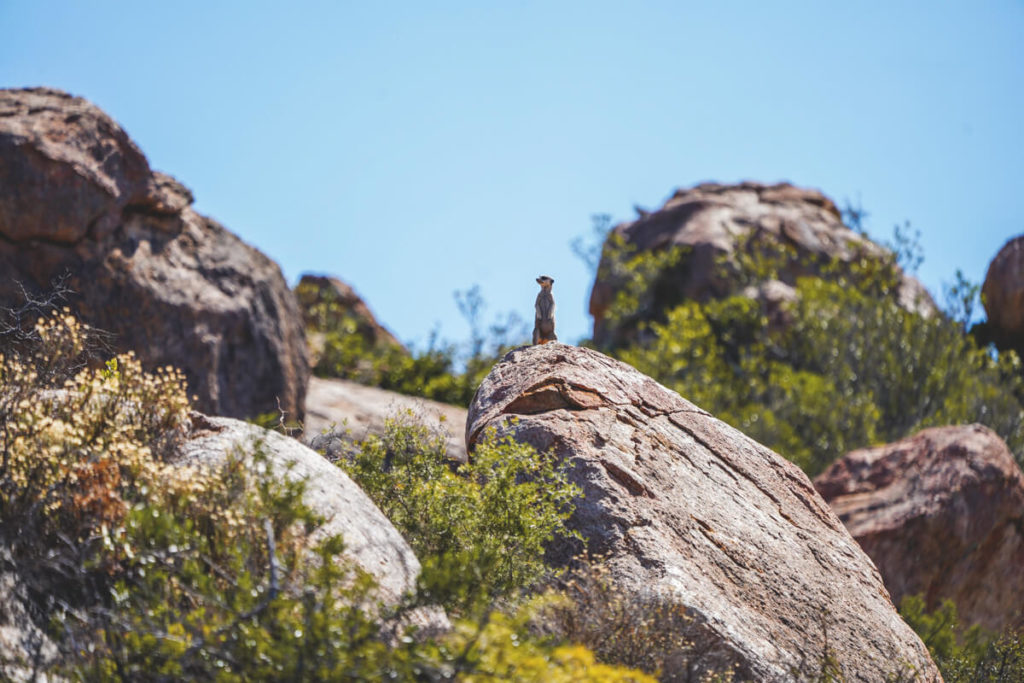
2. Goegap Nature Reserve
Once again, we started from our accommodation and drove to Springbok and a few kilometers further east to the Goegap Nature Reserve. At the gate, we paid the €2 entrance fee, took a map of the area, and continued to the parking lot. There wasn’t a soul in sight, except for three construction workers who were replacing the roof of the reception area. So we were the only visitors that day. Pretty crazy, but the high season was long over.
- Address: Goegap Nature Reserve, Airport Road, Springbok, 8240 South Africa
- Entrance fees: Adults R30, Children R18
- Opening hours: 7:30 a.m. to 6:00 p.m.
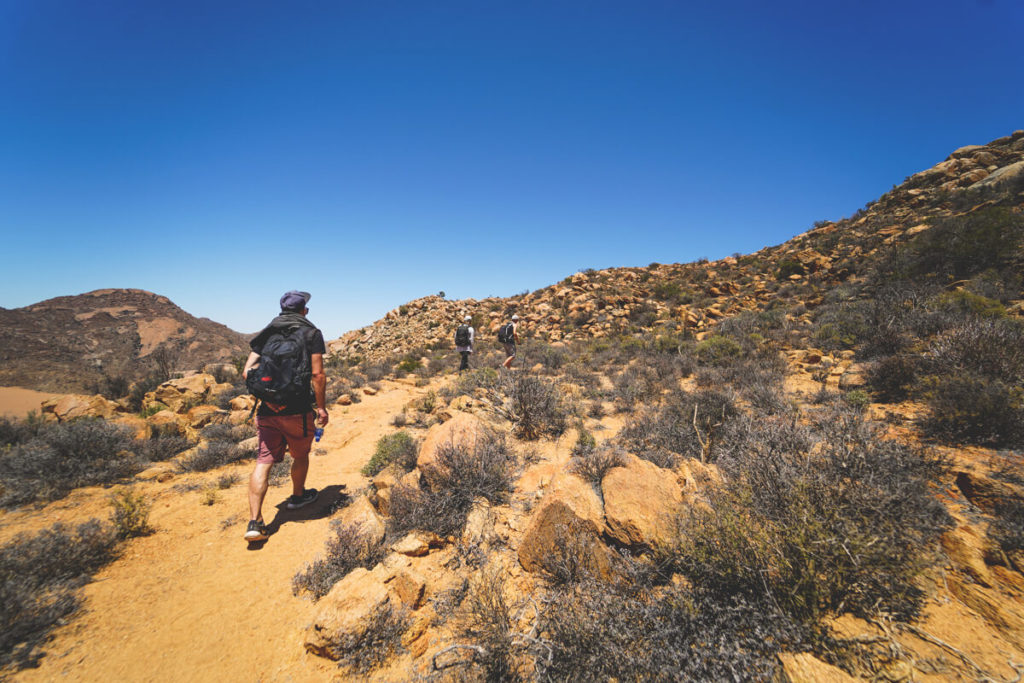
The Goegap Nature Reserve is a popular destination, especially during the flower bloom between July and September, when the landscape here too is transformed into a sea of flowers. While we were there, everything resembled a dreary lunar landscape of rocks and rubble, which we find absolutely fantastic.
The sandy plains, the barren hills, and the numerous succulents truly impressed us. And no matter where we are in the world, we are always grateful for every moment, every experience, and every adventure.
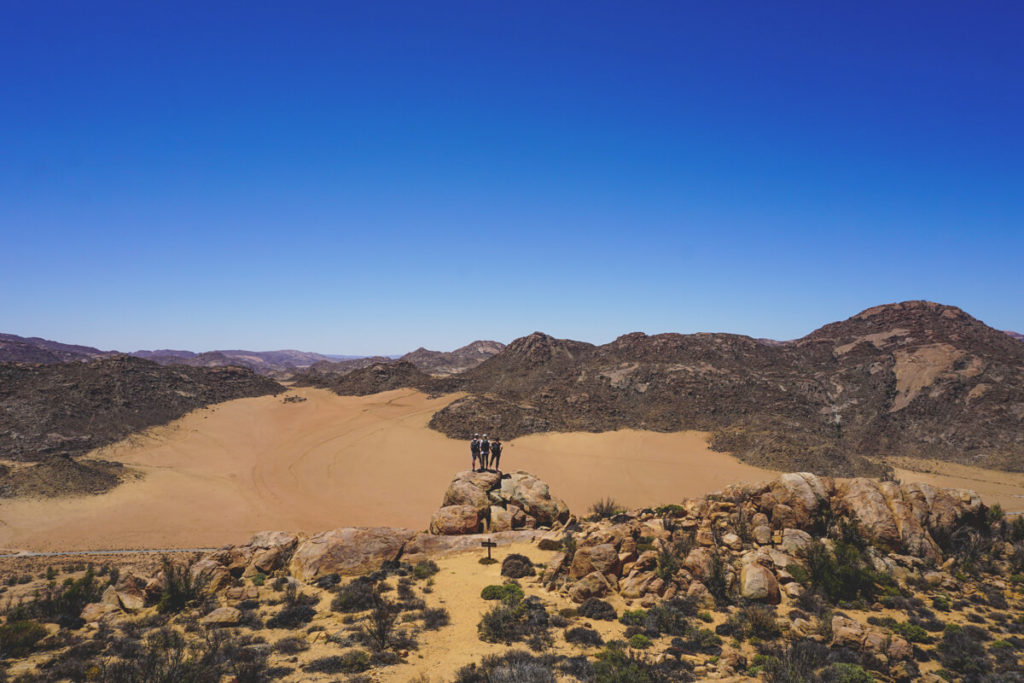
Hartmann’s Zebra, Oryx Antelopes, and Co.
At the Goegap Nature Reserve, you can expect to find more than 590 different plant species (mostly succulents), more than 90 bird species, as well as Hartmann’s Zebras, Oryx Antelopes, jackals, various buck species, reptiles, and amphibians. We “only” saw Oryx Antelopes; all the other animals were probably somewhere shadier in the heat.
The thermometer climbed well above 30°C when we were there. Plenty of water, a hat, and lots of sunscreen are essential in such temperatures! We were out for almost 3.5 hours and had a really cool day there despite the heat.
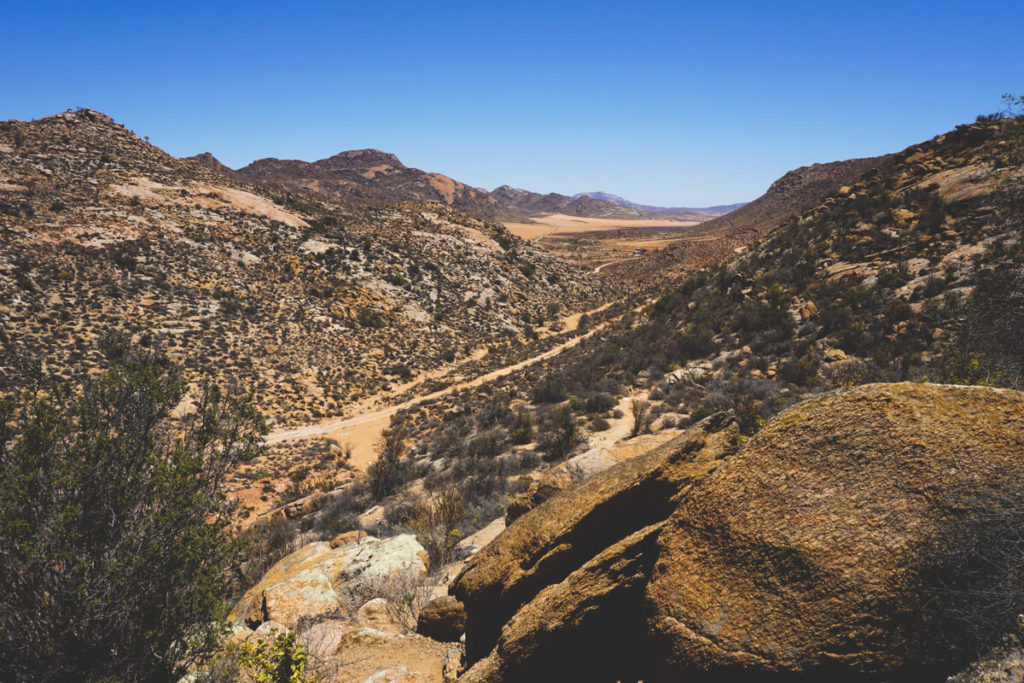
We opted for the long circular route (yellow trail). There is also a short circular route and a section accessible only by off-road vehicle. The trails are signposted and color-coded (yellow, blue, green) at the parking lot and picnic area. If you decide to travel to the Goegap Nature Reserve during the flower bloom period, you should book a guided tour in advance.
3. Augrabies Falls National Park
We were so excited about Augrabies Falls National Park, and finally, the time had come. Due to the heat and drought, we didn’t expect much water in the Orange River and at the waterfalls, but we were confident. The Orange River originates in the Kingdom of Lesotho and then flows all the way through the country to the Atlantic. It is the longest river in South Africa, measuring around 2,200 kilometers.
Here in Augrabies Falls National Park, the river divides into many small channels and then plunges 56 meters into the depths. There are pictures where the masses of water are hard to believe and come from all directions. We were lucky and were able to marvel at at least one “small” waterfall. When there is a lot of water, the waterfall spreads over 150 meters. The rocky gorge is 18 kilometers long and up to 200 meters deep.
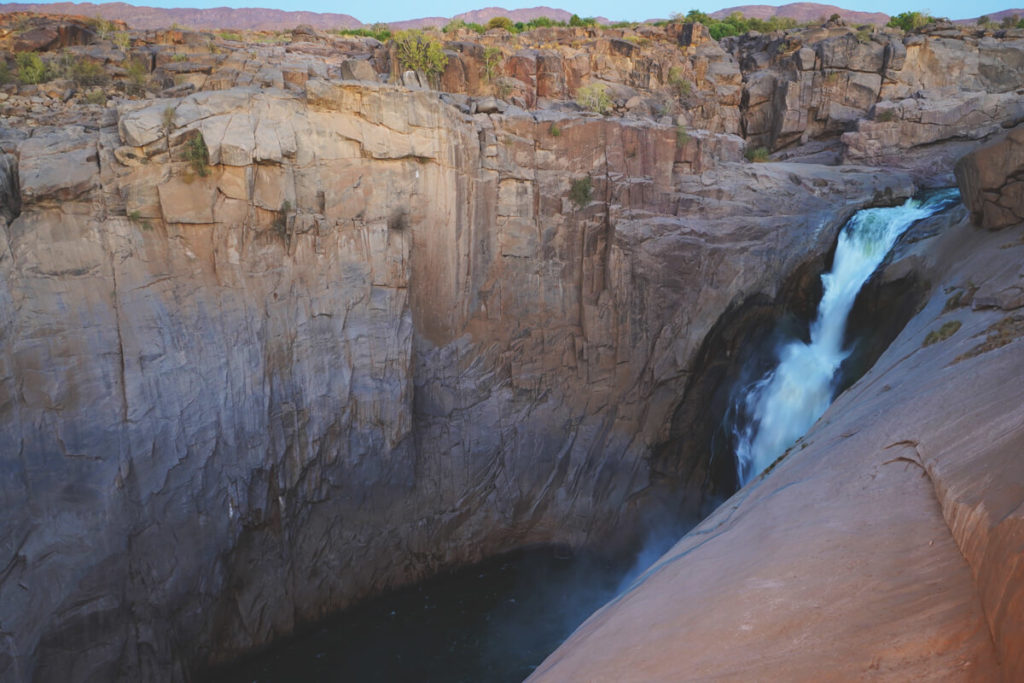
Great viewing platforms
From the reception, paths lead to the six viewing points, which are connected by wooden walkways. The park offers several hiking trails, a wildlife viewing area, and trails for mountain bikes and regular bicycles. The viewing points are in a great location and offer great photo opportunities. Also keep an eye out for the small, colorful lizards (Augrabies Flat Lizards) that roam the rocks and platforms.
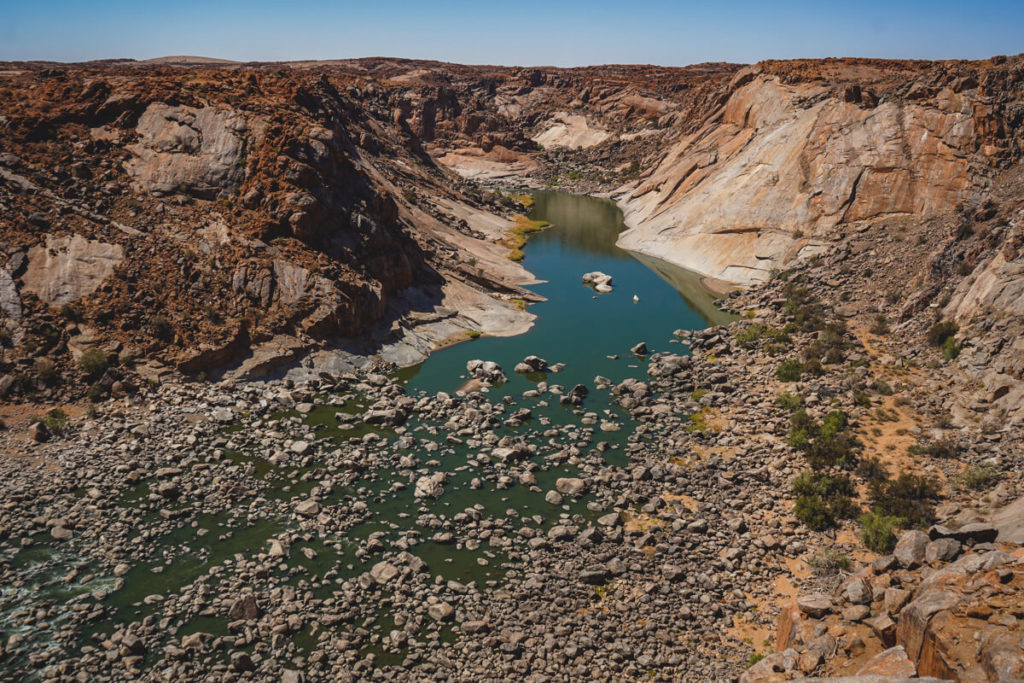
We took a night drive with a ranger and also drove through the park ourselves to spot the various animals. In addition to the many plant species, the park is home to more than 181 bird species, 20 species of snakes, 29 species of lizards, and 49 mammal species (oryx, giraffes, wild cats, rock dassies, baboons, zebras, kudus, leopards, caracals, and hyenas). Our detailed article can be found here: Augrabies Falls National Park in South Africa
- Address: Augrabies, 8874, South Africa
- Entrance fee: Adults R266, Children R133
- Opening times: 224 ZAR (13.79 €) per day.
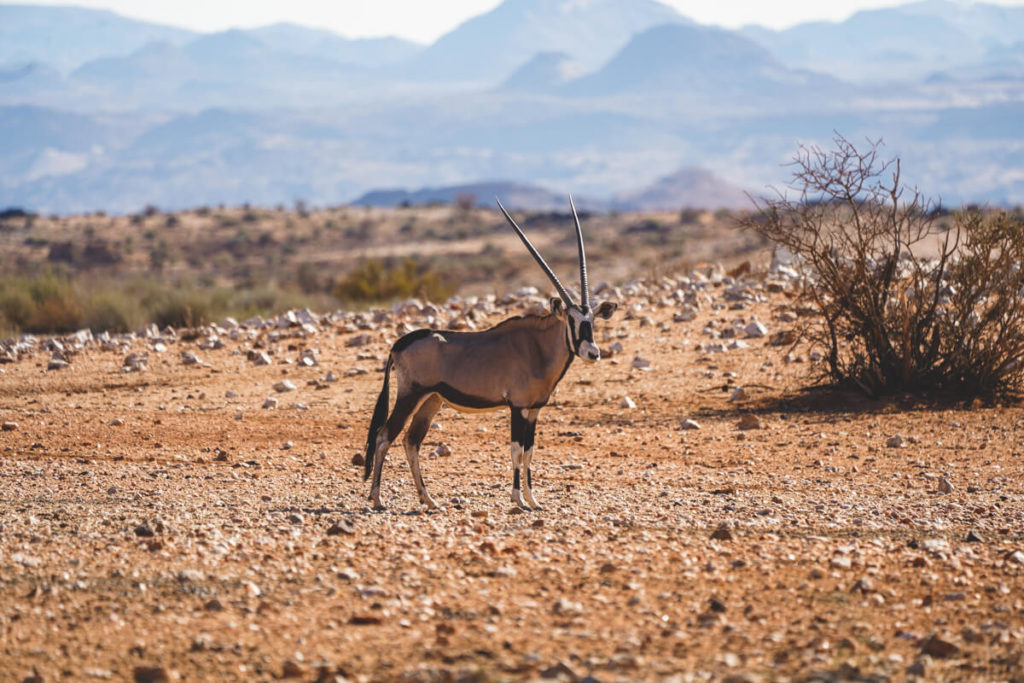
4. !Xaus Lodge
One of the absolute highlights of our trip was definitely our stay at the !Xaus Lodge* (pronounced “Kaus”). To reach this accommodation, we first had to drive for two hours through the Kgalagadi Transfrontier National Park, and then another 90 minutes across 91 dunes to the lodge.
The journey alone was insane! Completely cut off from any civilization, we spent two wonderful nights and days in the middle of the Kalahari Desert. The 12 wooden huts are connected by a wooden walkway. There’s a central lounge area, a small pool with loungers, and food served three times a day.
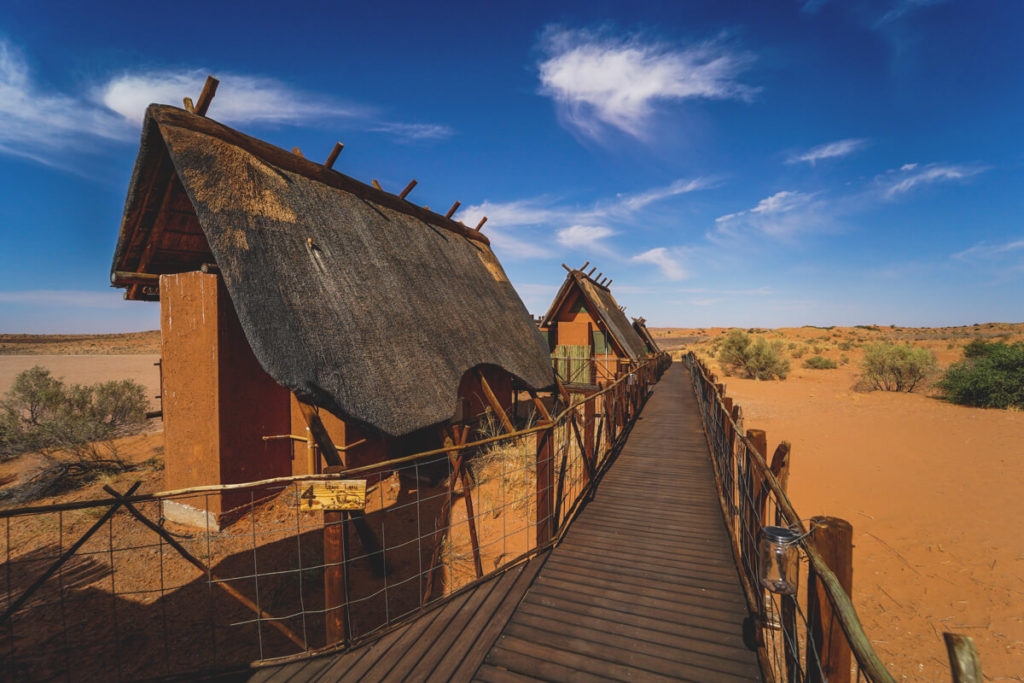
Electricity is only available for a few hours twice a day, and water comes from one of the boreholes. There’s no reception or internet access there, only radio in case of emergency. We thoroughly enjoyed this incredible silence, the sounds of the wilderness, and the many wonderful activities with our charming guide, Khalley.
We can’t really describe in words how beautiful this place is. The lodge is perched on a dune ridge directly in front of a huge salt pan. The view is spectacular and makes you realize how unique and magical nature is.
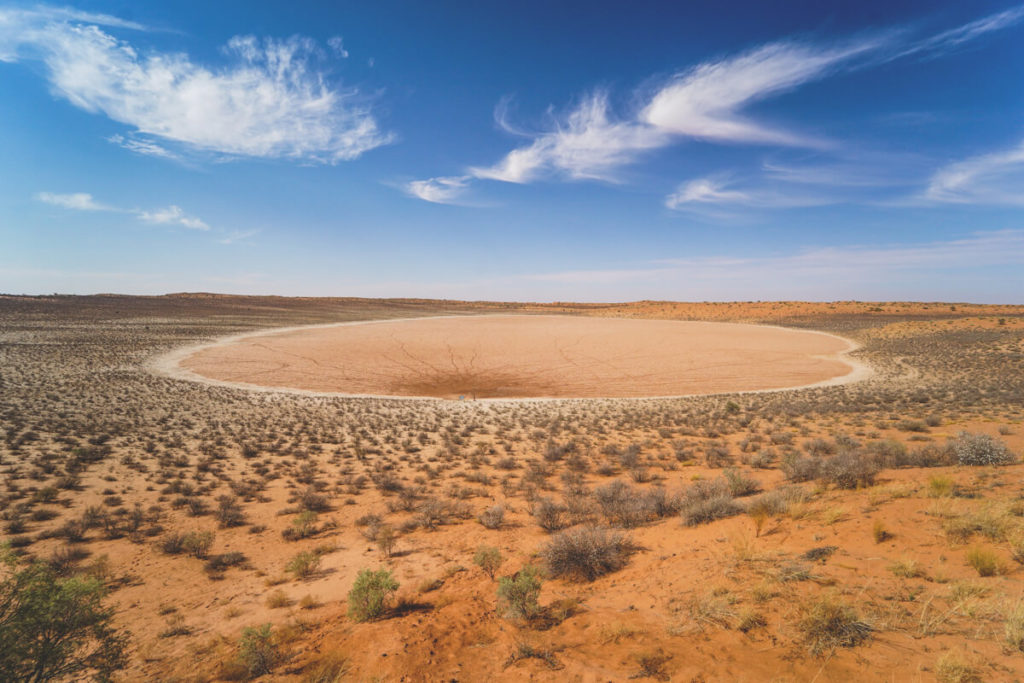
Tracking with Khalley
During our jeep tours and bush walk through the desert, we learned how to read tracks in the sand, identify sounds, and what it means to survive in the drought. Khalley told us more about the plants and animals of the desert and answered all our questions. We were also able to watch the Bushmen making traditional jewelry.
This lodge is a very, very special place, which is why there is a separate post about it. It simply needs much more space to give you a better understanding of this place. However, you can already see our entire stay (pictures and videos) in our highlights on Instagram under “Kgalagadi SA.”
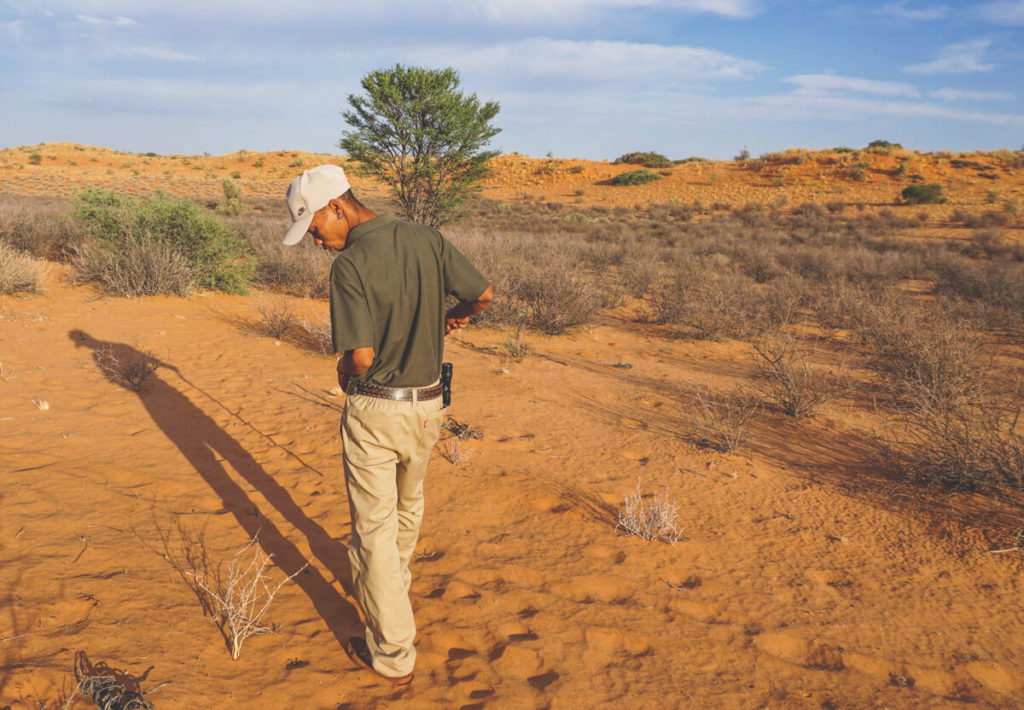
5. Kgalagadi Transfrontier National Park
After our days at the !Xaus Lodge, we now had three days left to explore the Kgalagadi Transfrontier National Park. Our accommodation was the Kgalagadi Lodge, located right outside the gates (Twee Rivieren) of the park. The national park is now a transfrontier conservation area in the Kalahari Desert. We were so excited to see the park, its animals, and its vegetation. This park was one of our absolute dream destinations in all of South Africa, simply because we find these dry desert regions so fascinating.
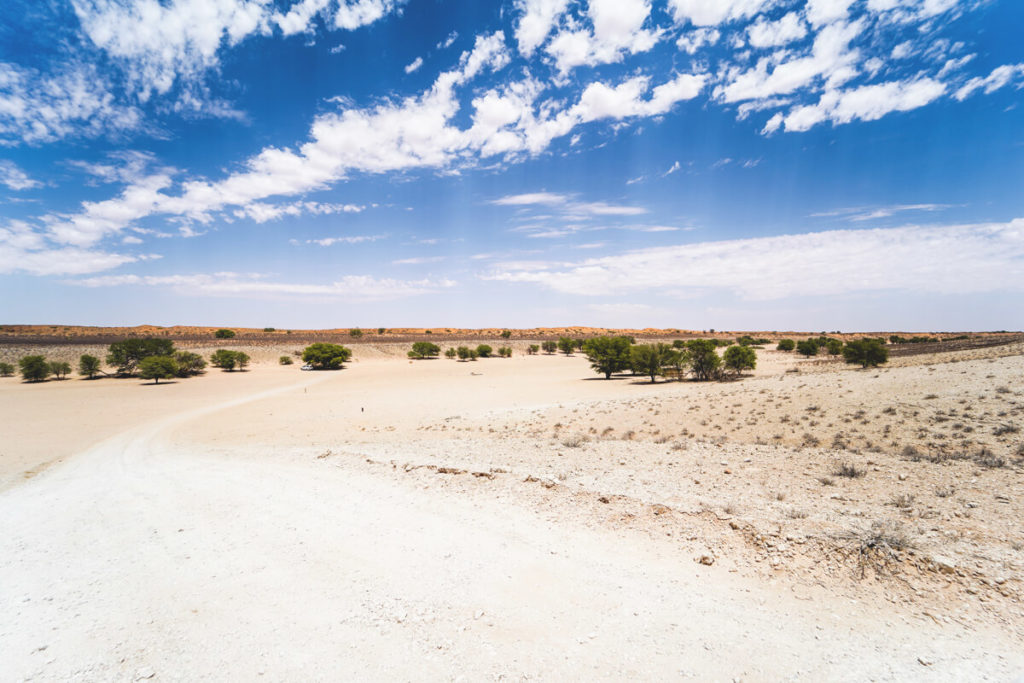
The park is still very pristine, without the frills of the other parks. There are a few toilet cabins, a few benches for picnics, and a few camps for overnight stays. Nothing is fenced in the park itself, which makes the whole experience a bit more exciting.
It’s practically “use the toilet at your own risk.” The sand tracks can be driven on with a regular car, but a four-wheel drive vehicle is much more comfortable. It gets very shaky and rocky here and there. The roads sometimes stretch like chewing gum, and the maximum speed is 50 km/h.
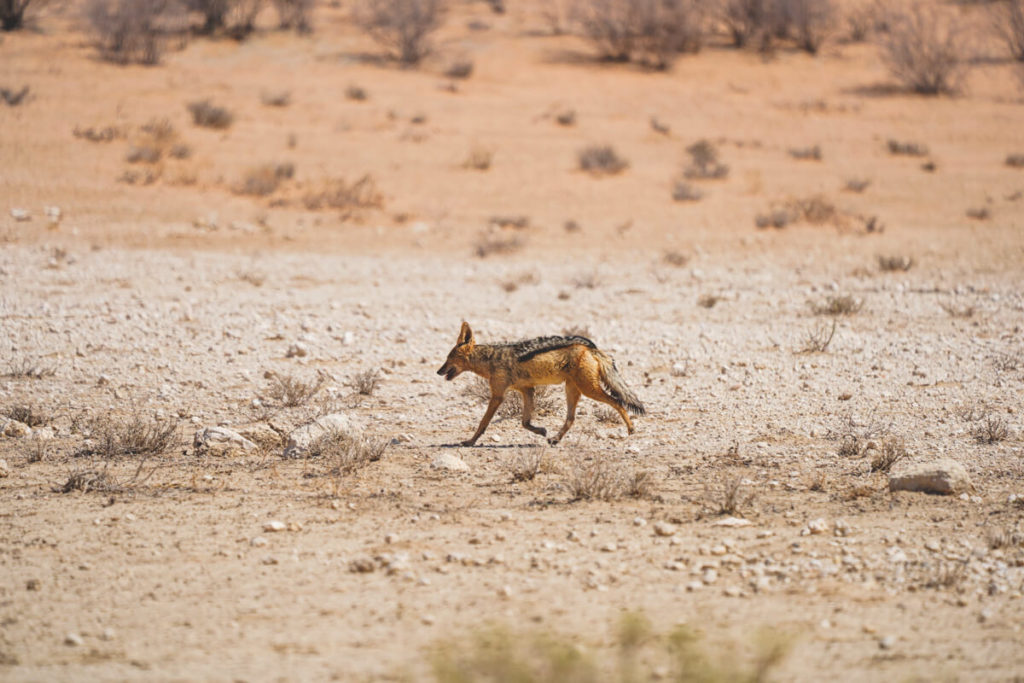
Some people told us we would definitely see the Kalahari lion with its black mane. We were excited and kept an eye out on every drive. And we did indeed see many lions, many antelopes, meerkats, vultures, owls, falcons, various other bird species, bucks, wildebeests, tortoises, foxes, mice, hares, jackals, and giraffes.
The vegetation ranged from red sand dunes with small bushes to dry savannah with dried-up riverbeds. We also saw countless carcasses at the waterholes in the park, which is part of the cycle of life in the wild. More about it here: The unique Kgalagadi Transfrontier National Park.

6. Further Highlights and Tips
This time, we took our time to explore the individual parks and tours. Animals and nature were clearly our top priority. Because of the long drives and distances, we missed out on a few things. For example, a visit to the Southern African Large Telescope in Sutherland. There are also the Riemvasmaak Hot Springs not far from Augrabies Falls National Park, but that would have been too much of a detour for us.
If you have more time, continuing on to Kimberley might be interesting for you. In the diamond city is the Big Hole as well as the Kamfers Dam, where thousands of beautiful Lesser Flamingos breed. The Akkerendam Nature Reserve near Calvinia is also said to be very beautiful.
We would have loved to visit the Ai-Ais/Richtersveld National Park, but it wasn’t on our route (Namibia border). Friends also found the Mokala National Park really beautiful because you can drive through the small park in one day and see many animals. There’s a lot to discover in the Northern Cape; we’ll definitely be back.
Our Accommodations
During the tour, we stayed in four different accommodations. Sometimes we had all-inclusive meals, sometimes half-board, and sometimes self-catering. Each accommodation was unique in its own way, and we can recommend each one without reservation.
In general, however, you should note that the selection of accommodations is significantly smaller than in other provinces. If you’re coming to the Northern Cape during peak travel season, you should book your accommodations well in advance.
One night at the Naries Namakwa Retreat (Manor House Room) costs between €160 and €190 per night for two people, including half-board. The bungalow at Augrabies Rest Camp cost around €95 per night for the two of us.
One night in the unique !Xaus Lodge costs €305 per person per night, all-inclusive and activities included. For the Kgalagadi Lodge, you’ll need to budget around €80 for one of the cool chalets for two people.
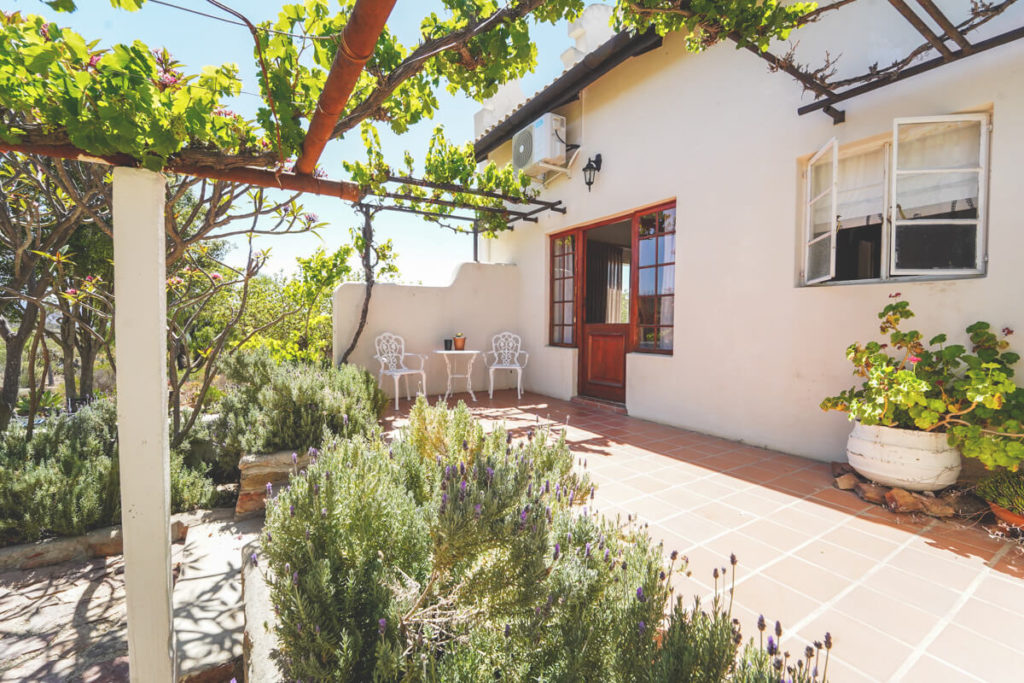
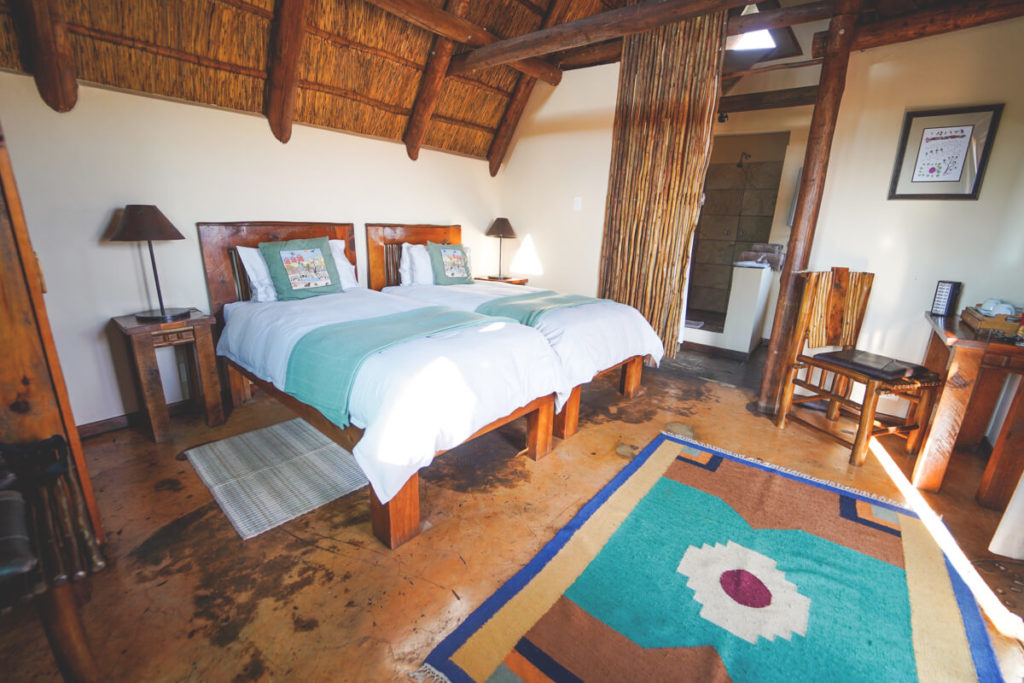
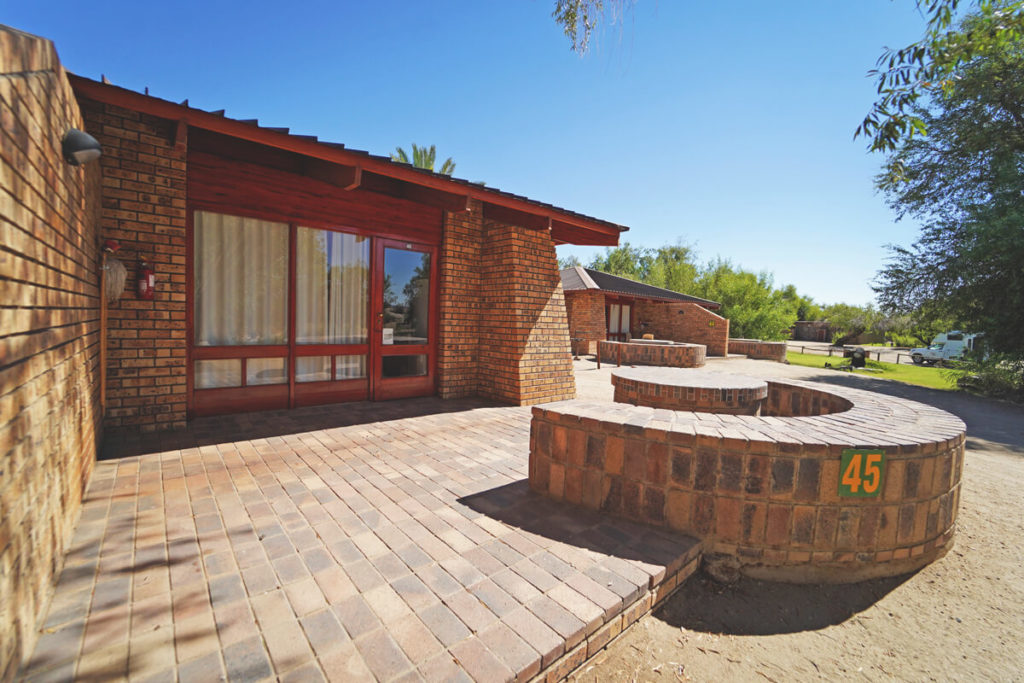
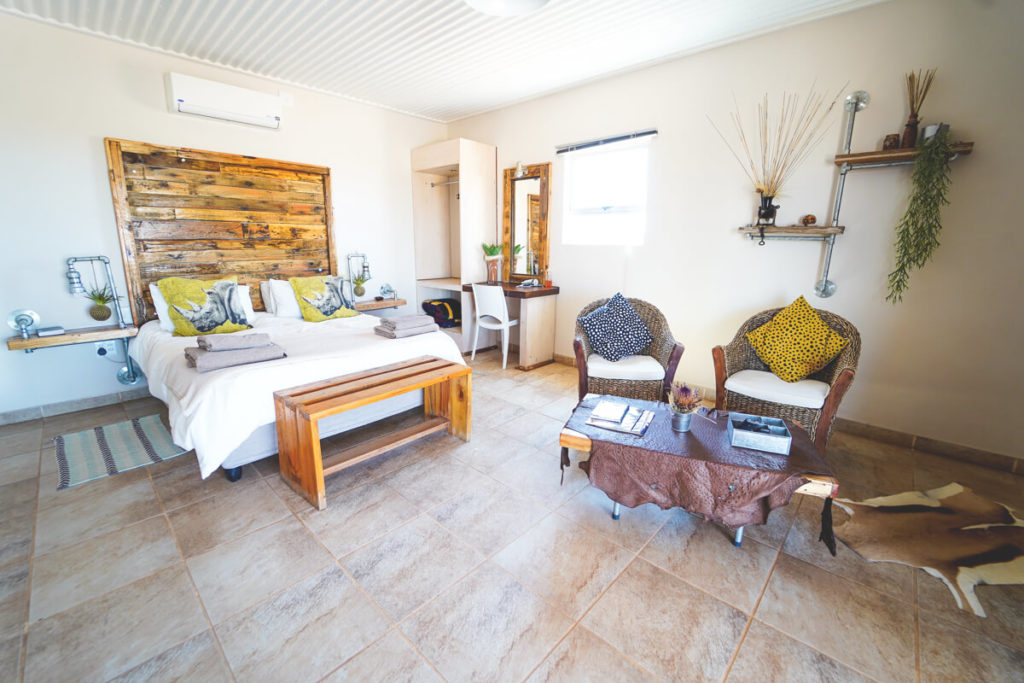
Cost Overview & Budget
In the following table, we’ve listed the approximate costs of this trip (excluding flights). This, of course, varies depending on your taste, budget, and requirements. In general, you can travel to the Northern Cape much more cheaply; it all depends on the accommodation you choose.
We spent two nights at the !Xaus Lodge, which, at just under €1,200, represented almost a quarter of the total cost. The rental car, at almost €1,000, wasn’t exactly a bargain either. In the end, this trip cost around €1,900 per person (excluding flights).
Best time to travel: Northern Cape
We had many discussions on site and learned about the climate in the Northern Cape. The largest and also warmest region in the country awaits you with warm to very hot temperatures year-round.
Most visitors come between July and September, when the flowers are in full bloom and many landscapes are transformed into a sea of flowers. At this time, it is also not quite as hot. The hot climate can cause temperatures to climb to 45°C to 50°C in summer.
If you look at the many climate tables, you can clearly see that it cools down somewhat between May and August, with an average of “only” 20°C to 25°C. At this time, it can get surprisingly cold at night, with temperatures around 4°C to 8°C.
Most rain falls between December and March/April. Tropical storms can also occur with short but heavy rain showers, transforming the Kalahari Desert into a green oasis.
Best conditions: June to August
According to climate tables, the best time to travel is in winter between June and August/September when it is dry and not quite so hot (approx. 25°C). As already mentioned, however, it can get quite cold at night.
Observing animals is also easier in winter, as the dryness causes many animals to seek out waterholes. At this time, there is naturally more going on in the parks, and many accommodations are booked out long in advance.
Things you should bring with you
For the Northern Cape, you should definitely bring enough sunscreen*, a hat, and binoculars for animal observation* and the starry sky. We can also only recommendWe recommend bringing a telephoto zoom lens. We rented the Sony 100-400mm again from our favorite rental company* for the duration of the tour. This allowed us to take fantastic photos of the animals again. It doesn’t make sense for us to buy such an expensive lens if we only use it once a year. Therefore, we always rent specialized equipment.
For the Northern Cape, you should also bring sturdy shoes for hikes and walks, a music box* (USB stick or CD) for long drives, and enough storage space* for your camera. As for clothing, everyone has to decide for themselves what they would like to bring. Long trousers and a long top should be in your luggage for cold evenings and excursions through the bush and in the jeep. A small daypack* is very useful for excursions. We always bring a foldable one.
Our conclusion about the Northern Cape
What an incredibly intense and beautiful trip! We had read a lot, heard a lot, but when we arrived we were completely blown away by the beauty of this region and the wildlife. We have never learned so much about the plants and animals on any other trip to South Africa.
These endless expanses, the unique starry sky, the red sand dunes of the Kalahari Desert, this silence… ah… we will never forget it. The Northern Cape in South Africa is a very special place and clearly shows how many faces the country has.
If you want solitude, silence, vastness, stone deserts and an authentic and real South Africa, then you should definitely visit this province.
Our FAQ – Short & Crisp
Is a trip through the Northern Cape in South Africa worth it? How much time should you plan? When is the best time to travel to the Northern Cape? How much does a trip to the Northern Cape in South Africa cost? Is it dangerous in the Northern Cape in South Africa?